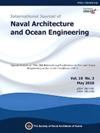船厂电气设备设计二维图纸中电缆连接信息的自动提取
IF 3.9
3区 工程技术
Q2 ENGINEERING, MARINE
International Journal of Naval Architecture and Ocean Engineering
Pub Date : 2024-01-01
DOI:10.1016/j.ijnaoe.2024.100630
引用次数: 0
摘要
本研究提出通过使用机器学习进行文本分类和基于预训练深度神经网络(DNN)的图像分类来检测电缆路线,从而自动分析接线图以生成电缆列表。在造船厂,每艘船都要绘制许多图纸,分析这些图纸,特别是接线图,为材料清单(BOM)生成电缆清单可能是一项耗时且容易出错的任务。这个过程是通过手动读取电缆路线并将信息输入电子表格来执行的。为了应对这些挑战,本研究旨在实现从接线图中提取信息的自动化。该过程包括从PDF文档中提取文本并使用机器学习对其进行分类,然后使用基于dnn的图像分类来跟踪电缆路线并识别相关注释。在3个PDF接线图样本上进行了测试,平均准确率达到90%左右,验证了算法的有效性。本文章由计算机程序翻译,如有差异,请以英文原文为准。

Automatic extraction of cable connection information from 2D drawings for electrical outfittings design in shipyards
This study proposes to automate the analysis of wiring diagrams to generate cable lists by using machine learning for text classification and pre-trained Deep Neural Network (DNN)-based image classification to detect cable routes. In shipyards, many drawings are produced for each ship, and analyzing these drawings, especially wiring diagrams, to generate cable lists for the Bill of Materials (BOM) can be a time-consuming and error-prone task. This process is performed manually by reading the cable routes and entering the information into a spreadsheet. To address these challenges, this study aims to automate the information extraction from wiring diagrams. The process involves extracting text from the PDF document and classifying it using machine learning, followed by using DNN-based image classification to trace cable routes and identify the relevant annotations. The developed algorithm was tested on three PDF wiring diagram samples and achieved an average accuracy of about 90%, confirming its effectiveness.
求助全文
通过发布文献求助,成功后即可免费获取论文全文。
去求助
来源期刊

International Journal of Naval Architecture and Ocean Engineering
ENGINEERING, MARINE-
CiteScore
4.90
自引率
4.50%
发文量
62
审稿时长
12 months
期刊介绍:
International Journal of Naval Architecture and Ocean Engineering provides a forum for engineers and scientists from a wide range of disciplines to present and discuss various phenomena in the utilization and preservation of ocean environment. Without being limited by the traditional categorization, it is encouraged to present advanced technology development and scientific research, as long as they are aimed for more and better human engagement with ocean environment. Topics include, but not limited to: marine hydrodynamics; structural mechanics; marine propulsion system; design methodology & practice; production technology; system dynamics & control; marine equipment technology; materials science; underwater acoustics; ocean remote sensing; and information technology related to ship and marine systems; ocean energy systems; marine environmental engineering; maritime safety engineering; polar & arctic engineering; coastal & port engineering; subsea engineering; and specialized watercraft engineering.
 求助内容:
求助内容: 应助结果提醒方式:
应助结果提醒方式:


